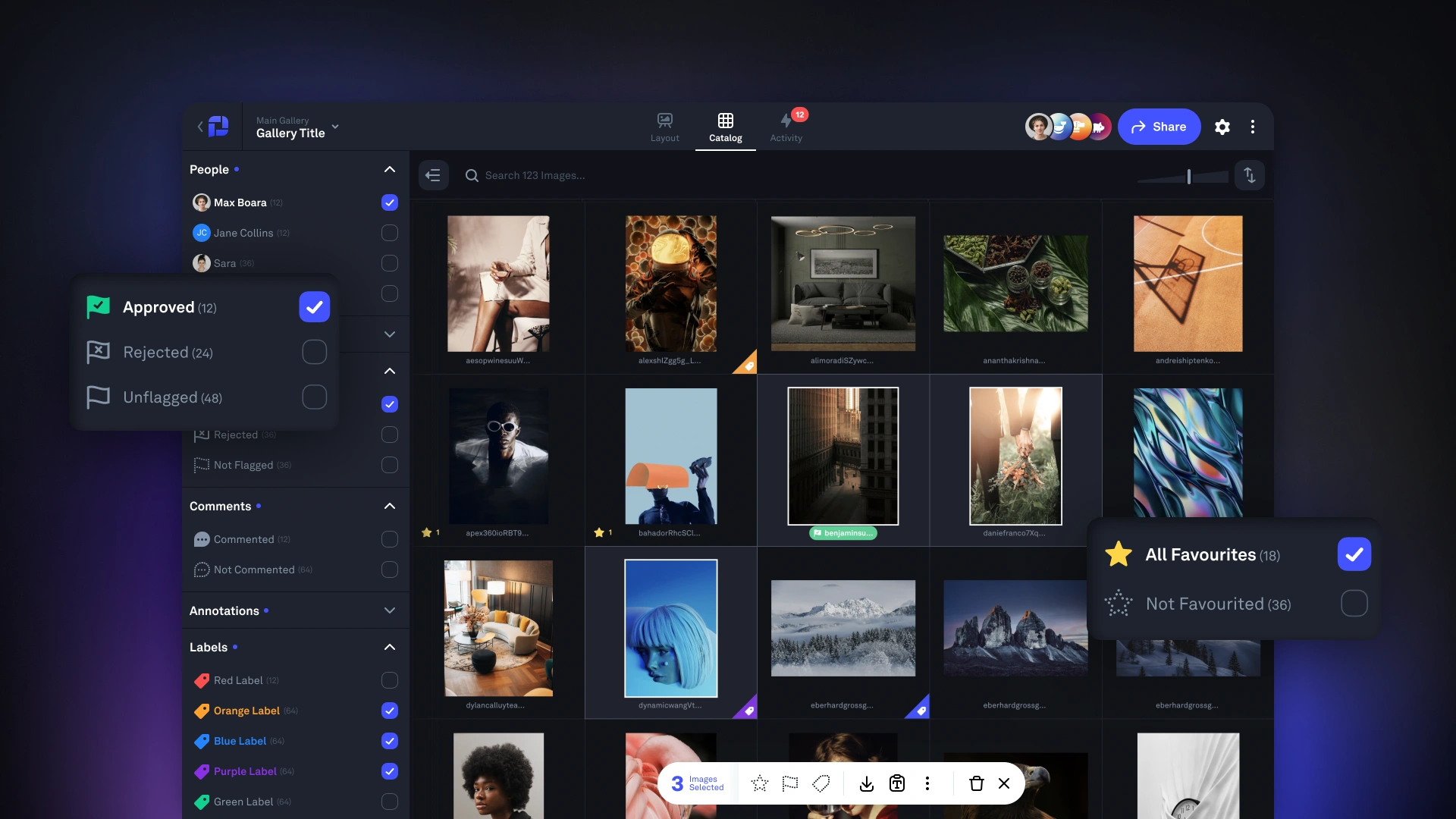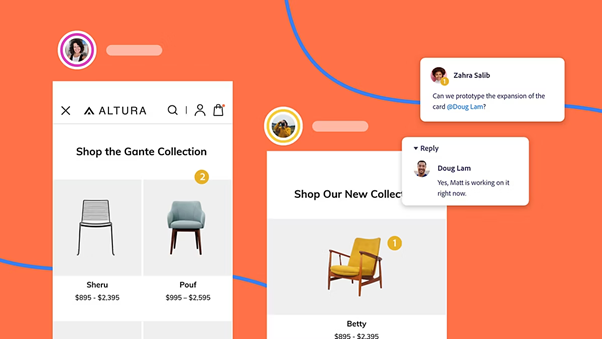We Reviewed the Best Creative Collaboration Tools
Creative collaboration is notoriously difficult—the last thing you need is for your tools to be slowing you down. That's why we've done the research and put together a list of the best creative collaboration tools available.
)
Helpful Summary
Overview: We review six of the best creative collaboration tools for working on creative projects.
Why trust us: We’re trusted by 10,000+ creative professionals, brands, and agencies thanks to our creative collaboration tools.
Why this is important: Creative collaboration tools can transform project management by facilitating seamless communication and streamlined workflows.
Action points: Our top picks are Picflow, Affinity, Adobe XD, Asana, Trello, and Miro.
Further research: Check out the Picflow Blog for more recommendations, tips, and how-tos.
Looking for the Best Creative Collaboration Tools?
Creative collaboration can be … tricky. Egos, unique perspectives, and intangible ideas can all be barriers to effective teamwork on creative projects. And with all of these inherent challenges, the last thing you need to be worrying about is clunky or inefficient tools.
So, in this Picflow guide, we’re introducing you to six of our absolute favorite creative collaboration tools that will help streamline everything from brainstorming to proofing.
But first…
Why Listen To Us?
At Picflow, a go-to tool for thousands of leading brands and professionals, including major names like Sheraton, Fstoppers, and Tag Heuer. They rely on Picflow to streamline collaboration on visual projects, so we know a thing or two about what works and what doesn’t.
What are Creative Collaboration Tools?
Creative collaboration tools are tools that facilitate teamwork and cooperation among individuals working on creative projects. This isn’t one specific kind of tool. Instead, it’s a loose collection of different software that serves different purposes.
Some (like Picflow) are designed to simplify the review and approval process for visual assets, while others (like Miro) are designed to help creative teams brainstorm. Both are very different—but they both fall under the umbrella of creative collaboration tools.
Benefits of Using Creative Collaboration Tools
Here are six benefits of using creative collaboration tools:
Enhanced Communication: Creative collaboration tools facilitate seamless communication among team members, enabling real-time messaging, video conferencing, and file sharing to foster collaboration regardless of geographical location.
Improved Efficiency: The tools can streamline workflow processes by centralizing project management, task assignment, and file sharing, reducing time spent on administrative tasks and enabling teams to focus on creative work.
Increased Collaboration: Creative collaboration tools promote collaboration by providing a platform for brainstorming, ideation, and feedback exchange, allowing team members to collaborate on projects in a structured and organized manner.
Enhanced Creativity: These platforms stimulate creativity and innovation by providing tools for visual brainstorming, digital whiteboarding, and multimedia creation. They allow team members to explore ideas and express their creativity in collaborative environments.
Remote Work Capabilities: Creative collaboration tools support remote work by enabling virtual collaboration and project management, ensuring that teams can continue collaborating effectively regardless of their physical location.
Version Control and Tracking: These tools offer version control and tracking features that allow teams to monitor project progress, track changes, and revert to previous versions, ensuring transparency and accountability throughout the creative process.
Criteria To Consider When Choosing A Creative Collaboration Tool
When selecting a creative collaboration tool, you may want to pay attention to these things:
User-Friendly Interface: When selecting a creative collaboration tool, prioritize usability by ensuring the interface is intuitive and easy to navigate.
Collaboration Features: Look for tools that offer real-time editing capabilities, allowing team members to work simultaneously on projects. Features like chat functions, task assignments, and commenting options can streamline communication and video feedback processes.
Integration Capabilities: Consider collaboration tools that integrate with other essential software and platforms your team uses, such as project management tools, communication apps, and file storage systems, to streamline workflow and data management.
Security and Privacy: Prioritize collaboration tools that offer robust security measures, including data encryption, access controls, and compliance with industry regulations, to protect sensitive information and ensure user privacy.
Cost and Value: Evaluate the cost of the collaboration tool and its features, functionality, and potential impact on productivity and efficiency.
5 Best Creative Collaboration Tools
Check out our list of the best creative collaboration tools below:
Picflow
Adobe XD
Asana
Trello
Miro
1. Picflow
If you work with visual content and are looking for a tool that simplifies your review and approval process, Picflow may be a perfect fit.
Our online gallery tool is designed to simplify creative work by giving you a centralized place to store visual assets, share them with clients and team members, and collect feedback. It’s easy to create a stunning gallery in minutes, and you have tons of tools at your disposal to simplify collaboration (more on those in a bit).
 Whether you need to gather feedback from clients, managers, or team members, all you need to do is share the invite link.
Whether you need to gather feedback from clients, managers, or team members, all you need to do is share the invite link.
Key Features
Gallery Designer: Create stunning galleries with all kinds of different layout options for sections, image sizes, embeds, and more.
Review and Approval Tools: Simplify review and approval with approval lists, approval limits, tags, and labels.
Feedback Tools: Collect targeted feedback with image and video annotations, comments and threads, and action items.
Advanced Workflow Features: Access features like bulk actions, filename exports, and review filters help manage assets efficiently.
Security Options: Ensures content security through watermarking, password protection, and access controls.
Pros & Cons
Customizable galleries
Review tools like annotations and color labels
Supports bulk actions and filtering options
Mobile-responsive design
Security features
Client collaboration feature
Free plan available
Excellent customer support
Limited free plan
2. Adobe XD
 Adobe XD is a powerful tool that helps UI/UX designers create high-fidelity designs and prototypes.
Adobe XD is a powerful tool that helps UI/UX designers create high-fidelity designs and prototypes.
As part of the Adobe Creative Cloud, it integrates seamlessly with other Adobe apps, enhancing its utility for comprehensive design workflows. Adobe XD excels in interactive design, and it has some great collaboration features like real-time co-editing and commenting.
Key Features
Prototyping and Wireframing: Facilitates the creation of interactive demos and mockups, essential for user experience design.
Vector-Based Design Tools: Supports detailed graphic design with scalable vector graphics, making it ideal for everything from logo design to full-app interfaces.
Integration with Adobe Creative Suite: Works seamlessly with Photoshop, Illustrator, and other Adobe products, providing access to high-quality assets and design elements.
Real-Time Collaboration: Enables multiple users to work on the same document simultaneously, enhancing team productivity and communication.
Pros & Cons
Seamless integration with Adobe Suite
Efficient prototyping tools
Enhanced collaboration features
Vector design capabilities
User-friendly interface
Cross-platform functionality
Limited photo editing tools
Fewer templates and pre-made elements
3. Asana
 Asana is a versatile project management tool that facilitates task management, collaboration, and project tracking. It is designed to support all kinds of work, but it pairs well with creative work thanks to features like file attachments, portfolio views, and customizable workflows.
Asana is a versatile project management tool that facilitates task management, collaboration, and project tracking. It is designed to support all kinds of work, but it pairs well with creative work thanks to features like file attachments, portfolio views, and customizable workflows.
Key Features
Task Management: Create, assign, and track detailed tasks with options for due dates, assignees, and follow-up.
Project Planning: Utilize flexible views such as lists, boards, and timelines to manage projects from initiation to completion.
Real-Time Updates: Facilitates immediate synchronization across all team members’ devices and project views.
Customizable Dashboards: Tailor project dashboards to highlight key metrics and gain insights into project status and health.
Pros & Cons
User-friendly interface
High customizability
Comprehensive integration
Effective task management
Strong mobile support
Effective for team collaboration
Automation features
Reliable customer support
Reporting features may not meet the needs of all teams
4. Trello
Trello is a flexible project management and collaboration tool that organizes your projects into boards, lists, and cards.
 It’s not the most advanced project management tool out there, which actually makes it a great fit for creative teams that find it difficult to work within strict project constraints. There are also built-in collaboration tools like comments, file uploads, and checklists that make communicating and staying organized as a team easy.
It’s not the most advanced project management tool out there, which actually makes it a great fit for creative teams that find it difficult to work within strict project constraints. There are also built-in collaboration tools like comments, file uploads, and checklists that make communicating and staying organized as a team easy.
Key Features
Kanban Boards: Visualize project tasks on customizable boards for a clear overview of work progress.
Cards: Checklists, labels, due dates, attachments, and more can expand the details of individual tasks.
Automation: Utilize Butler to automate routine actions and rules within boards, reducing repetitive manual tasks.
Integrations: Connect Trello with other applications like Slack, Google Drive, and Jira to streamline workflows.
Pros & Cons
Visual project management
Customizability
Ease of use
Strong integration capabilities
Effective for remote collaboration
Automation tools
Flexible use cases
Free tier available
Limited reporting features
5. Miro
Last up—Miro.
 Miro is an online collaborative whiteboarding platform designed to enable teams to work effectively, regardless of location. The platform is a central hub for brainstorming and planning, with tools for working through problems visually, supporting creative meetings, and collaborating on projects.
Miro is an online collaborative whiteboarding platform designed to enable teams to work effectively, regardless of location. The platform is a central hub for brainstorming and planning, with tools for working through problems visually, supporting creative meetings, and collaborating on projects.
Key Features
Infinite Canvas: Provides a vast workspace that allows teams to manage and display all their ideas and projects without spatial restrictions.
Pre-built Templates: Offers a wide range of templates for different use cases like user story maps, business models, mind maps, and more.
Real-time Collaboration: Team members can work simultaneously on the board with tools for drawing, writing, and adding multimedia elements.
Interactive Widgets: Includes voting, timer, and other interactive tools to facilitate engagement during collaborative sessions.
Pros & Cons
Enhanced visual communication
Cross-functional use
User-friendly interface
Strong integration ecosystem
Effective synchronous and asynchronous collaboration
Interactive features for engagement
Users have reported slowdowns when boards become overly complex
Conclusion
Overall, creative collaboration tools are essential for teams to work together efficiently and produce innovative work.
Choose the best tool for your team's workflow and watch your creativity soar. At Picflow, we support creative workflows by allowing users to create and share galleries, gather feedback through advanced proofing tools, and manage media with customizable options for efficient collaboration.
Try Picflow for free now!

)